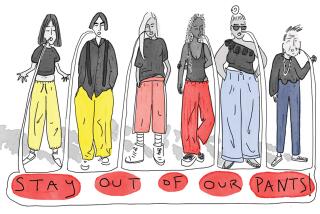MEN AND WOMEN Dressing the Part <i> edited by Claudia Brush Kidwell and Valerie Steele (Smithsonian Institution Press: $40, cloth, $24.95, paper; 188 pp.) </i>
- Share via
“Men and Women: Dressing the Part” is too stiff and dressy a title for a book that might better have sported a more casual label. The argument the book hopes to make is that clothing expresses the subordination of women; because male symbols are more highly valued, any moves toward sexual equality in this area have entailed women’s adoption of men’s clothing. “If and when equality comes,” the text states, “both men and women will be free to express their unique individuality drawing from the broad vocabulary of masculinity and femininity.” This conclusion has no firmer support than avant-garde designer Rudi Gernreich’s 1970 vision of men and women wearing miniskirts and trousers interchangeably--although the authors take a dim view of his sexually differentiated sketches. A serious discussion of gender identity and sexual inequality demands sterner stuff.
There is no need to impose on this wealth of subject matter any single, restrictive theory of the functions of clothing. The articles--written by several contributors--suggest a wide variety of links between gender identity, cultural values, social interactions and dress. The discussions provide much of substance, from the impact of mass production on clothing design and policemen’s early resistance to wearing uniforms to the evolution of sportswear from the mid-19th Century to the present. One chapter asks why today’s infant clothing is more sex-typed than in the past. Prior to World War II, boys’ first haircuts and first trousers were described as traumatic for the mother. Tracing the changes in toddler dress, the article concludes that parents since World War I have become increasingly preoccupied with teaching their young children “sex roles,” ostensibly for their psychological health.
More to Read
Sign up for our Book Club newsletter
Get the latest news, events and more from the Los Angeles Times Book Club, and help us get L.A. reading and talking.
You may occasionally receive promotional content from the Los Angeles Times.








